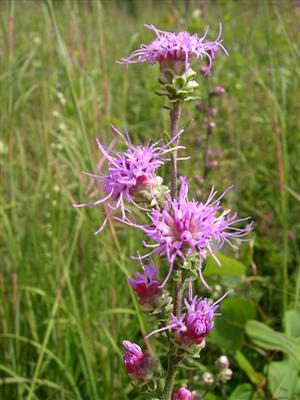Printed at http://www.newmoonnursery.com/index.cfm/
Liatris squarrosa
Scaly blazing star
Native to North America
FIRST IMPRESSIONS: Liatris squarrosa is a showy drought tolerant perennial wildflower. Plants are up to 2’ tall with upright or arching stems clothed in narrow grass-like leaves. In late summer tufted rosy purple flower heads are frequented by butterflies and other pollinators. Plants are tough and drought tolerant prospering in sunny sites with lean dry soils.
HABITAT & HARDINESS: Liatris squarrosa occurs in the eastern United States from Delaware to Michigan and South Dakota and south to the Florida panhandle and Texas.
Plants are indigenous to high quality natural areas including dry prairies, limestone or sandstone glades, sunny bluffs, open sandy or rocky woodlands and barren savannas.
Plants are hardy from USDA Zones 5-9.
PLANT DESCRIPTION: Liatris squarrosa is a robust perennial that produces one or several upright or arching stems from rounded woody underground corms.
Leaves are linear and wide spreading. The blades are medium green with a glabrous or shortly pubescent surface. The largest basal leaves are about 1/4” wide and 6” long. They become progressively smaller as the stalk rises.
Stems terminate in a single flower head or a loose spiky inflorescence containing 3-26 widely spaced heads. The flat topped heads are about 1” across with green scaly recurved bracts. Heads consist of 15-45 orchid colored disc florets with curly exerted styles.
Blooming begins at the top of the flower stalk and progresses downward. The flower display lasts 3-4 weeks beginning in summer and continuing until autumn. This species is one of the earliest gayfeathers to bloom.
After flowering, soft tufts of fluffy golden brown achenes drift on the wind to new homes.
Plants are 1-2’ tall with a 1-2’ spread.
CULTURAL & MAINTENANCE NEEDS: Liatris squarrosa is a tough cookie that flourishes in xeric-types sites with full sun and lean dry soils.
Plants tolerate drought and loamy, clay, sandy or rocky soils with slightly acid or alkaline pH. This species will grow in most average well drained garden soils but will flop if soil is too rich or moist.
This species resents encroachment by other plants. Give it space in garden situations and an occasional controlled burn to reduce woody vegetation in wild areas.
Plants are prized for their ability to attract native bees, skippers, butterflies and hummingbirds. Rabbits, deer and livestock can nibble the foliage and stems. The corms may be preyed on by small rodents.
LANDSCAPE USES: This is a good choice for a Wildlife Garden, Rock Garden or dry Prairie. Plants are also used as Cut Flowers, Butterfly Nectar Plants or as part of a Grouping or Mass Planting. Liatris squarrosa has Showy Blooms and is appropriate for Cottage Gardens, Water-wise Landscapes, Low Maintenance Plantings, dry Meadows and Perennial Borders.
COMPANION & UNDERSTUDY PLANTS: Try pairing Liatris squarrosa with Andropogon gerardii, Asclepias verticillata, Aster oblongifolius, Echinacea purpurea, Eryngium yuccifolium, Monarda punctata or Solidago nemoralis.
Liatris aspera is a much taller gayfeather that could be a suitable replacement due to similar flowers and habitat needs.
TRIVIA: Liatris squarrosa can be distinguished from its Liatris spp. relatives due to its early bloom time, shorter stature, preference for drier locations and the prominent recurved bracts of the flower heads.
Height:
1-2 ftSpread:
1-2 ftSpacing:
18-24 inUSDA Hardiness Zone:
5-9Bloom Color:
PurpleLiatris squarrosa Characteristics
Attracts Wildlife
- Pollinators
- Hummingbirds
- Butterflies
Attributes
- Coastal
- Clay Soil
- Rock Garden
- Naturalizing
- East-Coast Native
- Drought Tolerant
Exposure
- Full Sun
Flowering Months
- August
- July
Foliage Color
- Green
Growth Rate
- Fast
Season of Interest (Foliage)
- Summer
Soil Moisture Preference
- Dry

